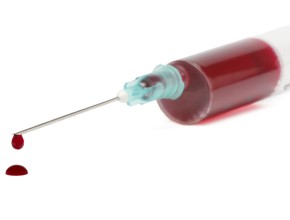Epistaxis in patients on antiplatelet drugs: tranexamic acid vs anterior nasal packing
A cotton pad soaked with tranexamic acid (TXA) was superior to anterior nasal packing (ANP) in patients with epistaxis.
This randomized parallel-group trial analyzed a total of 124 patients who presented to the emergency department (ED) with epistaxis while talking antiplatelet drugs. The initial treatment included 20 minutes of compression of both nostrils with the patient’s thumb and index finger. Among patients with persistent bleeding, one group — TXA group — received a cotton pledget soaked with 5 mL of a solution of 500 mg of TXA; the pledget was removed after visible bleeding has stopped. The other group — ANP group — received 10-minute treatment with a cotton pledget soaked in epinephrine (1:100,000) and 2% lidocaine followed by insertion of cotton pledgets covered with tetracycline ointment and left in place for 3 days.
Within 10 minutes of treatment, bleeding was stopped in 73% of patients in the TXA and 29% of patients in the ANP group. Discharge from the ED within 2 hours of starting treatment occurred in 97% of patients in the TXA group and 13% in the ANP group. Rebleeding within 24 hours was present in 5% versus 10% of patients, respectively, and within 1 week in 5% and 21% of patients. All differences except for rebleeding in the first 24 hours were clinically and statistically significant, as was the markedly better treatment satisfaction among patients who received TXA.
Risk of progression of monoclonal gammopathy of undetermined significance
Patients with monoclonal gammopathy of undetermined significance (MGUS), in comparison with people without this condition, have an over 6-fold increase in the risk of progression to multiple myeloma or other plasma-cell or lymphoid disorder.
MGUS is defined as the presence of a serum monoclonal protein (M protein) at a concentration ≤30 g/L, absence or low levels of monoclonal light chains in urine, ≤10% of monoclonal plasma cells in bone marrow, and lack of hypercalcemia, renal insufficiency, anemia, and bone lesions. It occurs in about 3% of people >50 years of age and in >5% of those aged >70 years.
In this study, the authors followed >1,300 patients with MGUS for up approximately 40 years. The median age at diagnosis was 72 years. Progression to multiple myeloma or other plasma-cell or lymphoid disorder occurred most commonly among those with IgM MGUS (at about 10 times the expected rate, mostly to non-Hodgkin lymphoma or Waldenström macroglobulinemia). A majority of patients had non-IgM MGUS; among them, the progression was less common (5.7 times higher than expected), resulting mostly in multiple myeloma and, less commonly, in AL amyloidosis. In the entire cohort, the risk of progression was 10% at 10 years, 18% at 20 years, and about 30% at 30 years. Risk factors for progression were higher serum M protein levels (≥15 g/L) and an abnormal ratio of kappa to lambda free light chains in serum (<0.26 or >1.65). The presence of both those risk factors, in comparison with the presence of none, increased the risk >3 times in IgM MGUS patients and almost twice in non-IgM MGUS patients; the presence of one risk factor increased the risk by at least half. After matching for sex and age, patients with MGUS had a shorter survival than patients without this condition, with a median of 8.1 versus 12.4 years, respectively.
The authors stress that there are no data suggesting benefits of screening or monitoring of those patients.
SCCM/ESICM guidelines for diagnosis and management of CIRCI: Part 3. Infections, bypass, cardiac arrest
Pastores SM, Annane D, Rochwerg B; and the Corticosteroid Guideline Task Force of SCCM and ESICM. Guidelines for the Diagnosis and Management of Critical Illness-Related Corticosteroid Insufficiency (CIRCI) in Critically Ill Patients (Part II): Society of Critical Care Medicine (SCCM) and European Society of Intensive Care Medicine (ESICM) 2017. Crit Care Med. 2018 Jan;46(1):146-148. doi: 10.1097/CCM.0000000000002840. PubMed PMID: 29095205.
These guidelines provide recommendations and suggestions (conditional or weak recommendations) on the diagnosis of critical illness–related corticosteroid insufficiency (CIRCI) among critically ill patients and use of corticosteroids in the management of the variety of critical care conditions where CIRCI may be present.
Strong recommendations are issued when most individuals would want the recommended course of action, clinicians should use this course of action in most situations, and recommendations could serve as policy and a performance measure. With weak recommendations (suggestions), the majority of patients would want the suggested course of action but many would not, clinicians should tailor their actions to individual circumstances and patient’s preferences, and the subject of policy may be the consideration of a given intervention rather than its institution. (The concepts of strong and weak recommendations are used according to the GRADE, or Grading of Recommendations, Assessment, Development, and Evaluation, method; see our introduction to the GRADE system).
In this part of the publication, the authors provide the following suggestions and recommendations, based mostly on moderate (M), low (L), and very low (VL) quality of evidence:
- Suggestion to use corticosteroids in patients hospitalized with community-acquired pneumonia (CAP) (M). The suggested corticosteroid dose for patients with CAP is <400 mg of hydrocortisone or equivalent per day for 5 to 7 days (M).
- Suggestion against the use of corticosteroids for adult patients with influenza (VL).
- Recommendation to use corticosteroids in the setting of bacterial meningitis (L). The authors are not explicit about the dose and treatment duration and have not varied their recommendation depending on the causative organism.
- Suggestion to use corticosteroids in the setting of cardiopulmonary bypass surgery (M). The authors are not explicit about the dose or treatment duration, mentioning one study using 250 mg of methylprednisolone at anesthesia induction and at bypass onset.
- Suggestion to use corticosteroids in the setting of cardiac arrest (VL). The authors are not explicit about the dose or treatment duration.
 English
English
 Español
Español
 українська
українська






